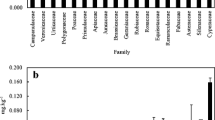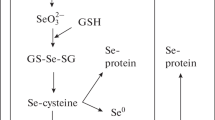Abstract
A mean selenium of 123 mg/kg dry wt was observed in 195 samples of agricultural soils, and a mean of .158mg Se/kg dry wt in 304 samples of grassland soils collected at 354 sites in various regions of the Federal Republic of Germany. For grassland soil, a north/south gradient of Se concentrations was observed. In the industrialized regions of the North, higher Se levels were generally observed, the highest value of .652 mg Se/kg dry wt at a site in Northrhine-Westphalia. The mean selenium content of grass from the respective collection sites was .045 mg/kg dry wt in all regions of the FRG, a level insufficient for the maintenance of health of farm animals.
The absence of a correlation between the soil-and grass-Se contents indicates that Se uptake by plants is not solely dependent on the presence of Se. Grass may be deficient in Se even if grown on Se-rich soils. Fixation of Se by acidic soils appears to be a major factor; the high Se levels in the soils of industrialized areas is not bioavailable. Based on these findings, it is concluded that locally produced feedstock must be supplemented with Se to prevent the outbreak of deficiency diseases in farm animals.
Similar content being viewed by others
References
Ernaehrungsbericht (1984), Dt. Ges. f. Ernaehrung (DGE) e. V./, Frankfurt, 1–256.
W. Oelschlaeger and K. H. Menke,Zschr. Ernaehrungswiss. 9, 208 (1969).
W. Oelschlaeger and K. H. Menke,ibid.,9, 216 (1969).
G. Gissel-Nielsen, U. C. Gupta, M. Lamand, and T. Westermarck,Adv. Agron. 37, 397 (1980).
S. E. Raptis, G. Kaiser, and G. Toelg,Fresenius’ Z. Anal. Chem. 316, 105 (1983).
M. Melcher, Atomic Absorption Applications Laboratory (Lab Notes), Nr. 17/D, Jan. 1978.
T. Yläranta,Ann. Agric. Fenn.,22, 122 (1983).
H. Bostedt,Der prakt. Tierarzt (Special issue)61, 45 (1980).
H. Bostedt and P. Schramel,Dtsch. Tieraerztl. Wschr. 90, 398 (1983).
G. Gissel-Nielsen, Selenium in Soil and Plants, Proc. 3rd Internatl. Symp., Stockholm (1985), 471–478.
M. Levesque,Can. J. Soil Sci. 54, 63 (1974).
A. M. Hurd-Karrer,J. Agric. Res. 50, 413 (1935).
G. Gissel-Nielsen,J. Sci. Food Agric. 24, 649 (1973).
W. Hartfiel, “Zur Selenversorgung von Wiederkaeuern,” VOLUFA-Schriftenreihe, vol. 16, 511–518 (1985).
Food and Nutrition Board, National Academy of Science (USA).
G. N. Schrauzer,Mnch. Med. Wchschr. 127, 731 (1985).
Author information
Authors and Affiliations
Rights and permissions
About this article
Cite this article
Hartfiel, W., Bahners, N. Selenium deficiency in the Federal Republic of Germany. Biol Trace Elem Res 15, 1–12 (1988). https://doi.org/10.1007/BF02990123
Received:
Accepted:
Issue Date:
DOI: https://doi.org/10.1007/BF02990123




